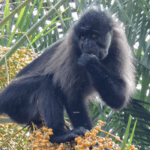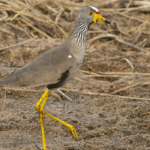The Greater and Lesser kudus antelopes in Uganda, the “Lesser Kudu” is the species of kudu antelope that can be found, primarily inhabiting the Pian Upe Game Reserve within the country’s northeastern region; they are known for their distinctive spiraled horns, striped coat, and preference for thick woodlands and acacia savannahs, where they can find cover and browse to eat.
With shoulder heights ranging from 100 cm to 150 cm, Greater kudu (Tragelaphus strepsiceros) is one of the tallest antelopes with the largest horns in the bushbuck tribe, averaging 120 cm in length. It is also strikingly handsome, with a grey-brown coat marked by thin white side stripes.
Greater kudu in uganda tours Scientifically referred to as Tragelaphus strepsiceros, the greater kudu is a woodland antelope known to thrive in southern and eastern Africa including uganda where it is explored on Wildlife safaris in uganda
The greater kudu together with the leaser kudu are the sub-species of kudu and though it is recorded to feature a wide spread territory, its population is sparsely distributed due to habitat loss and poaching. The greater kudus feature narrow bodies with long legs while their coats range from brown to reddish brown with 4- 12 vertical white stripes along their torso as viewed on African safaris which include the Uganda safaris and tours. The head of greater kudu is relatively darker than other body parts.
The bulls of greater kudu are notably larger than cows and do a lot of vocalization using low grunts, humming and clucks along with gasping. The male greater kudus feature large manes that run along their throats and the horns featuring 2 to 3 twists. The bulls start to grow the horns between 6 – 12 months of age while twisting occurs when they reach the age of 2 years and the full twisting occurs at the age of 6 years.
Male kudu have the largest horn of any antelope’s species, spiraling up to 6feet. Each horn makes about 2.5 graceful twists. Kudu can leap over obstacles that are 8 feet high with ease.
The greater kudu is much sought after by hunters, both for the magnificent horns of the bulls and more generally for their high-quality meat. They are one of the most commonly hunted species in southern Africa, and generate the highest proportion (13.2%) of hunting income in South Africa but in Uganda because poaching is prohibited.
These beautifully shaped horns have long been prized in Africa for use as musical instruments, honey containers and symbolic ritual objects. In some cultures, the horns are thought to be the dwelling places of powerful spirits, and in others, they are a symbol of male potency.
Leopards, lions, wild dogs, hyenas, eagles, and pythons will prey on lesser kudu and their young. Humans also hunt lesser kudu for their meat, hides, and horns. Lesser kudu have large ears and excellent hearing to alert them to the presence of predators.
Females live in small herds with each other and their young. Males may live alone or with other males except for breeding. Her life provides protection from predators, but kudu can also run—fast, up to 60 miles per hour means can run up to 96 km/h!
Despite their large size, kudu are accomplished jumpers. They are super agile and can easily jump a height of 2 meters; when stressed they are known to jump as high as 3.5metres!
Rarely aggressive in the wild, kudu only fight with opponents of the same size and age. During such sparring contests, males slowly approach each other, lock horns, and push back and forth until one surrenders.
Regarding to reproduction, the greater kudus attain the sexual maturity between 1 -3 years of age and the gestation period takes about eight months after which a single calf is born. Greater kudus have a lifespan of 7 to 8years in the wild, and up to 23 years in captivity. They may be active throughout the 24-hour day. Herds disperse during the rainy season when food is plentiful in Africa.








